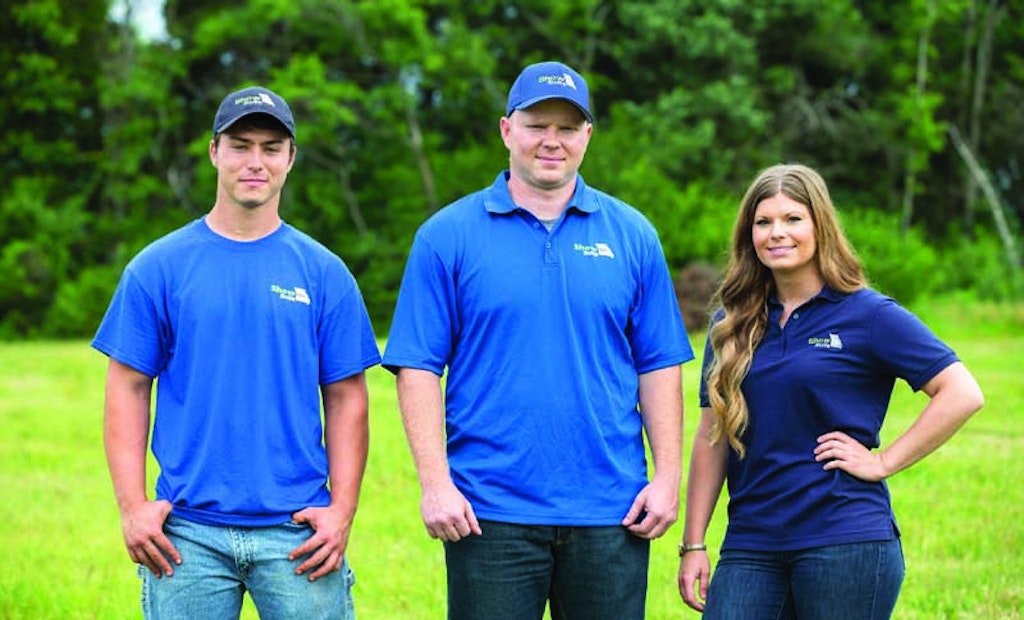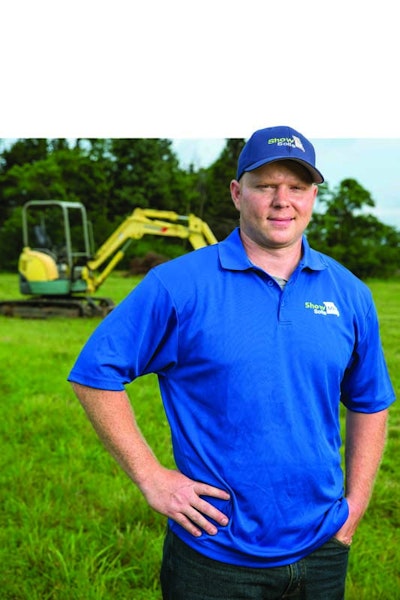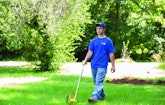
Interested in Repair?
Get Repair articles, news and videos right in your inbox! Sign up now.
Repair + Get AlertsChris Chapman grew up in the onsite treatment business, “dragging pipe” on his father’s installation projects from the time he was 10 years old. So it’s not surprising that he wound up in the industry, although the route he took to get there was a bit unconventional.
His company, Show Me Soils, specializes in soil evaluations for onsite systems in Franklin County and other Missouri counties west of St. Louis. It’s fully separate from the original family business, Chapman Contracting, founded by his father, John Chapman Sr.
Show Me Soils does business with Chapman Contracting but also serves multiple other installation contractors and engineers. Chris Chapman built his 4-year-old business with aggressive Internet-based marketing and with quality, responsive service that quickly turns first-time callers into steady customers.
His business also includes onsite system inspections for real estate transfers, and he’s a licensed distributor for Norweco treatment systems. He sees a bright outlook for the business: “The housing industry has taken off around here. The home inspectors are as busy as they can be, so that means homes are selling. And we’ve been seeing a lot of new construction, which is the backbone of everything.”
SUCCESS BY DEGREES
Chapman finished his business administration degree in management and marketing at Columbia College in Columbia, Missouri, at the height of the 2008 recession.
Seeing that at the time his degree “wasn’t worth the paper it was printed on,” he went back to college to study soil science at the University of Missouri, ultimately becoming a state-certified onsite soil evaluator.
He chose to study soils because he knew from his father’s experience that percolation tests were being phased out and systems were becoming more sophisticated, going from conventional septics to drip irrigation systems requiring week-long installations and backed by engineering drawings and soil science. “Dad saw an opportunity in soil evaluation, and he’s the one who convinced me to go back to school,” Chapman says.
He studied under Randy Miles, Ph.D., an associate professor of soil science at the university’s School of Natural Resources and a leading figure in the onsite treatment field. “He somewhat took me under his wing,” says Chapman. “I wouldn’t have been able to do it if not for him.”
After two years of soil science schooling, Chapman founded Show Me Soils in 2011. The company operates entirely independent of Chapman Contracting. “I started my own company so other contractors could work with me without fear of my being totally linked to my father’s business,” Chapman says.
DEMANDING RULES
Show Me Soils works in a 50-mile radius from the home base in St. Clair, about 45 miles from St. Louis. That area encompasses mostly Jefferson, St. Louis, St. Charles and Franklin counties, which require all onsite systems to be engineered.
Heavy clay soils pose the most common system design challenge, although some areas have high water tables and Jefferson County is known for rocky terrain. “In Jefferson County especially, we see small lots with horrible soils,” Chapman says. “There are some jobs where you can dig down and there will not be 2 inches of soil anywhere on the lot. Basically at that point you have to import soil. I’ve seen sites where the contractor had to completely import 30 inches of soil to make a system work.”
Replacements for failed systems on small lots tend to rely on drip irrigation: “It has a small imprint. You can fit it in tight spots.”
For most soil tests, Chapman meets with an engineer on the site. Sometimes the installation contractor and property owner are also present. Typically, the soil test quickly dictates the type, size and location of the system. “That way everybody knows exactly what’s going on right away instead of sitting in limbo for a week or two,” Chapman says.
Interacting on site with property owners can be difficult since most don’t enjoy learning that they need an advanced system that costs more than they expected.
“People don’t really care what kind of soil it is,” Chapman says. “They care about one thing: how much the system is going to cost. When I first started I would sugarcoat things. I’ve gotten completely away from that. I’m direct. I tell them how it is.
“I pride myself on being frugal and practical, but I’m not going to recommend a system that I don’t believe will work. I’ve figured out how to tell people that trying to save $1,000 here or $500 there is going to backfire on them in the long run. I’m not about to let them get by with a conventional system that will be surfacing in their yard three years from now.”
EQUIPPED FOR SUCCESS
For soil tests, Chapman arrives on site with a Dodge 2500 pickup towing a Yanmar ViO35 mini-excavator, an 8,000-pound rubber-tracked machine with a 2-foot-wide bucket. “It’s much better suited than the rubber-tired machines some people use,” he says. “I can go on those tracks into subdivisions where the homes have $50,000 worth of landscaping and you can barely tell where I came in and out. Yet the machine has enough weight so that in July, when it’s dry as a bone, I can still dig pits 5 feet deep.”
On each site, he digs three to six pits, depending on county regulations. Jefferson County requires two additional pits to evaluate a reserve drainfield area. Chapman uses a standard Munsell soil color chart to identify soil types. He marks the soil horizons with 6-inch concrete nails and measures them using a flexible seamstress-style tape ruler. He takes a sample from each horizon, sprays each sample with a water bottle to pinpoint its color, and checks each sample for texture, percent of coarse fragments, consistence, structure, roots/pores, and shrink/swell potential. From there an application rate is determined for each designated horizon.
Competition for soil evaluators is limited in the area. “There are only a few of us,” Chapman says. “Having my own machine gives me a competitive advantage. Some of the soil evaluators don’t have their own machine. They might only do evaluations on weekends, and they have to line up a contractor to dig the pits.
“These days it seems when anyone calls they need something done yesterday. I bring my own excavator and I do it all right there. If a contractor says he needs a soil test the next day, I might not get there that day but I’ll be out there the following day.”
REACHING CUSTOMERS
Internet searches are also a source of leads for Chapman’s system inspection business and savvy marketing helps him win ample opportunities to prove himself. “I am of the belief that the phone book is yesterday’s news,” Chapman says. “Others weren’t taking advantage of Internet marketing. Thanks to my marketing degree, I was able to. There was really no strategy except spending hundreds of hours with my website, constantly changing things, doing research, using Google AdWords, figuring out what worked and what didn’t.
“If someone’s septic system has backed up and they’re told they need a new system, contractors will often tell them, ‘You need a soil test.’ If they get on Google and type in ‘onsite soil testing,’ I’m going to appear as the top one on the page. I’m the first name they see, and that gives me an excellent chance to get the business.
“My reason for the website was to get people to call me. Once I get them on the phone and get a job, I rely on my work to speak for itself. I have tons of repeat customers who initially found me on the Internet. I get good customers and then benefit from their word-of-mouth. I still believe word-of-mouth is probably the best asset, but you have to get in the door first.”
POINT-OF-SALE PRO
Many older systems in the area need replacement or significant repair. “The biggest problem is homes that were built in the 1970s and 1980s with the expectation that sewers were coming,” Chapman says. “Thirty to 40 years later, sewers are still not there. The onsite systems weren’t intended to last that long, and there was never a plan to replace them.
“I can get a pretty good idea what I’m going to find just by the age, the lot size and what county the home is in. If the sellers have updated the septic system, they usually brag about it. If they paid $15,000 three years ago to update the system, that’s going to be in big, bold letters in the real estate listing. If I don’t hear anything about an update, I can assume it’s the original system. More than 60 percent of those need some major repair or updating.”
Chapman gets repeat business through connections with home inspectors, who largely prefer to delegate onsite system inspections, and with real estate agents. For his inspections, Chapman uses standard forms supplied by the state.
SALES AND MAINTENANCE
A small but potentially high-growth side of Chapman’s business is in sales and maintenance of Norweco treatment units through an exclusive distributorship in Franklin County and part of St. Louis County. He has sold about 50 of the systems in three years and handles the initial NSF-required two-year maintenance contracts. He is now training an employee, Brenden Murphy, to handle the maintenance side.
He sees reliance on advanced treatment systems increasing: “I think the lot sizes are going to get smaller and smaller, and the good building sites with great topsoil seem to be disappearing. We deal with more and more difficult sites on a daily basis.”
As those sites call for evaluations, local engineers and contractors can be sure Show Me Soils will be there to do the job.
Wastewater industry roots
Chris Chapman’s Show Me Soils business sprang from fertile ground in an onsite installation firm launched by his father, John Chapman Sr., in 1998.
Chapman Contracting filled what the elder Chapman saw as a void in the local market for a qualified onsite installation specialist. He had installed septic systems on weekends in the 1970s and 1980s while serving in the Missouri National Guard. A sergeant major attached to the Engineering Brigade, he supervised the equipment maintenance shop; he also had experience as a heavy-equipment operator and was a member of Local 513 Operating Engineers.
In March 2003, son John Chapman Jr. joined the company full time for the opportunity to serve the community, grow with the industry and work with family. He quickly gained experience in all aspects of the company, including estimating, job layout and onsite system service and repair. He now runs the day-to-day business as his father has semiretired. The company installs about 50 systems per year.
John Chapman Jr. sees a growing need for advanced treatment and dispersal systems because of soil and other site limitations. His Master Drain Layer Certification authorizes him to install systems in all counties in Missouri. “The septic industry isn’t a part-time job anymore,” he says. “It is becoming more and more specialized. The days of a guy hanging drywall one week and installing onsite systems the next are over.”
Efficient and reliable equipment is a top priority. The inventory includes a Bobcat T550 compact track loader, Bobcat S250 skid-steer, Yanmar B7-5 excavator, Cat 303CR excavator, Hitachi Ex 100 excavator, Cat 420 IT 4 x 4 backhoe, Finn power mulcher/straw blower, Chevy G3500 cutaway high-cube commercial utility van, Chevy C4500 flatbed, Sterling A9500 road tractor with 25-ton lowboy trailer, and a Dodge 2500 pickup truck.
The company emphasizes quality at prices that are competitive but not the lowest. The elder Chapman often said, “We’ve never lost money on a job we didn’t get,” and that those who compete on price alone “don’t stay in the phone book long.”
As for John Jr., he is deeply committed to the industry and the business and hopes sons John III and Joseph will one day join him in it.











